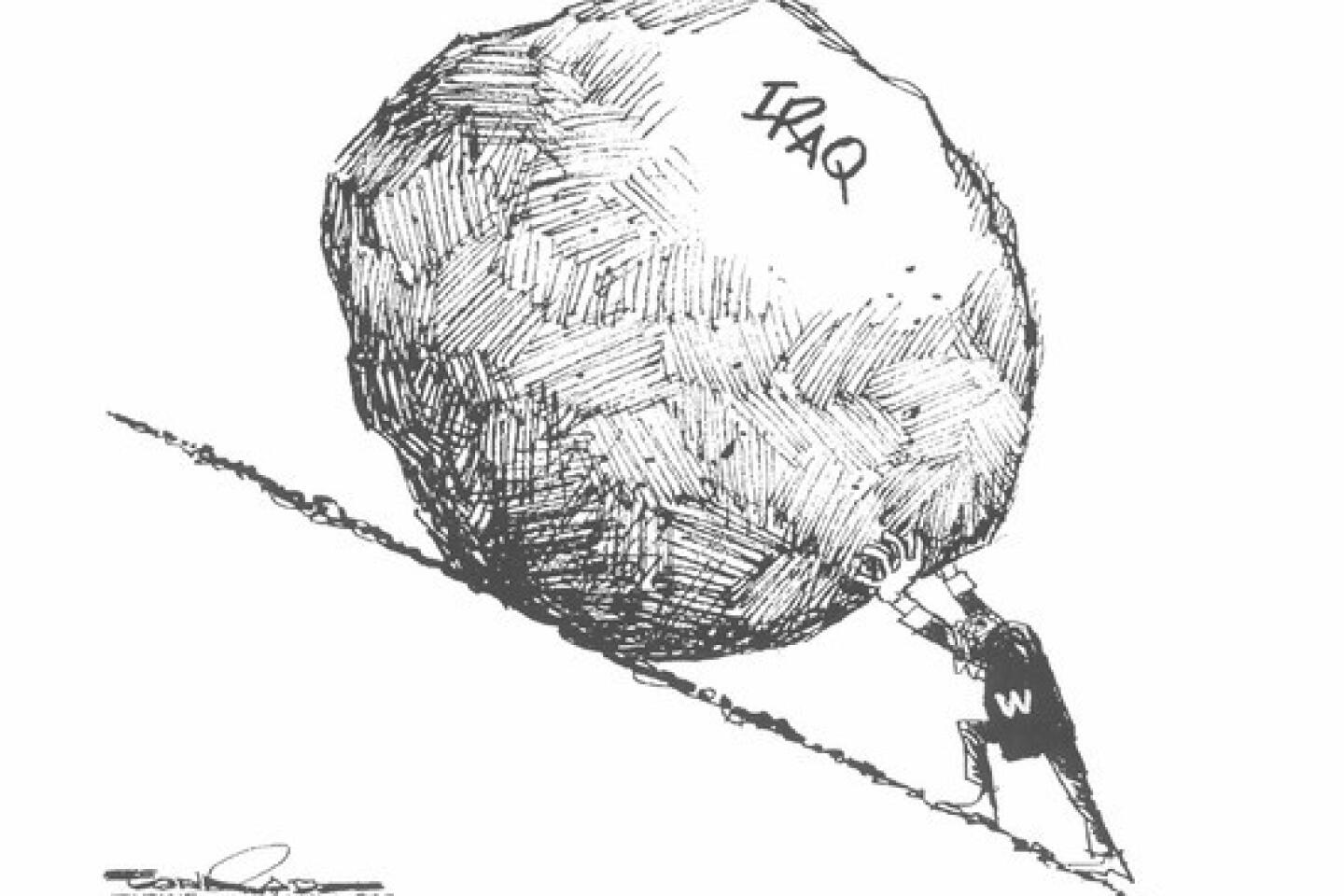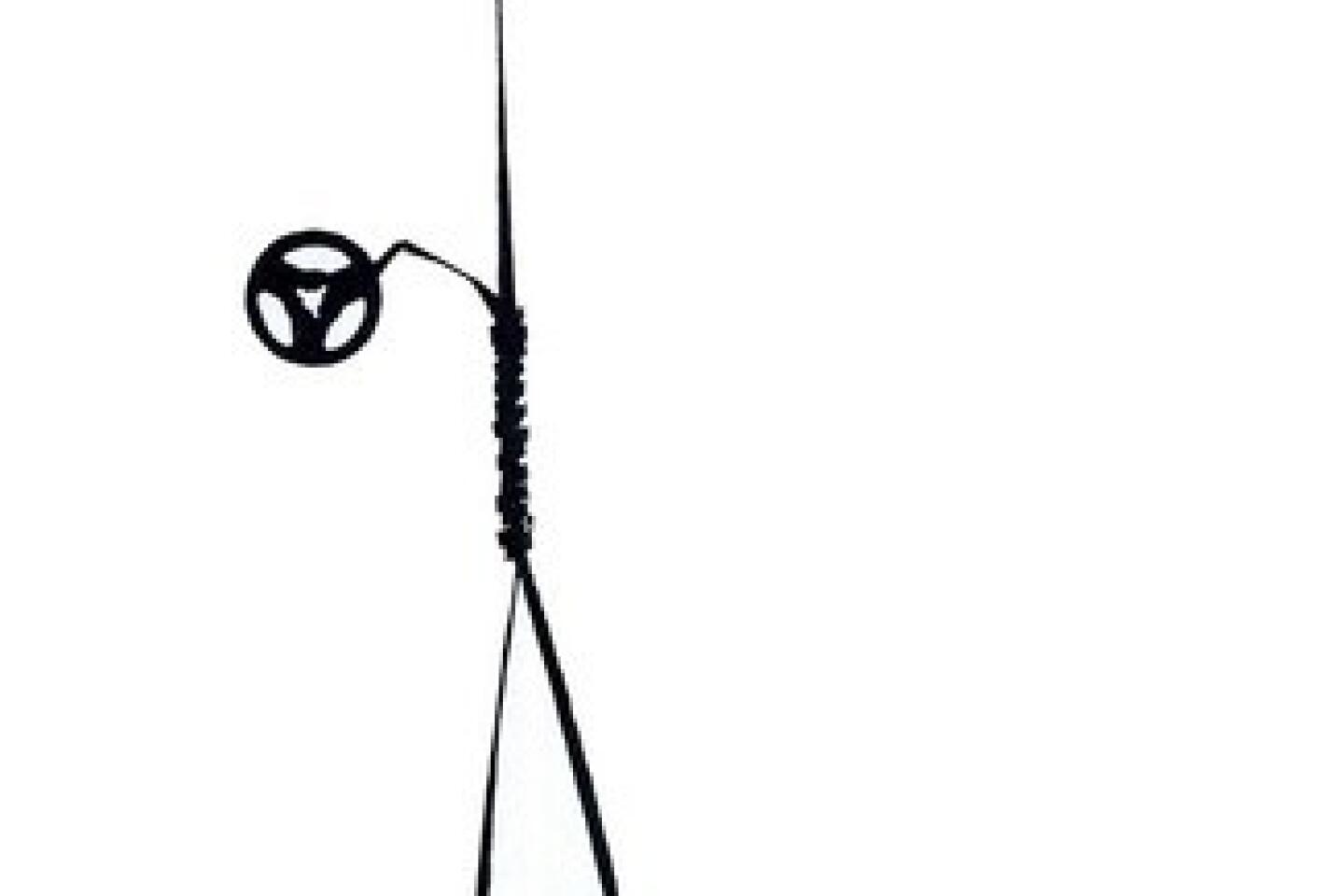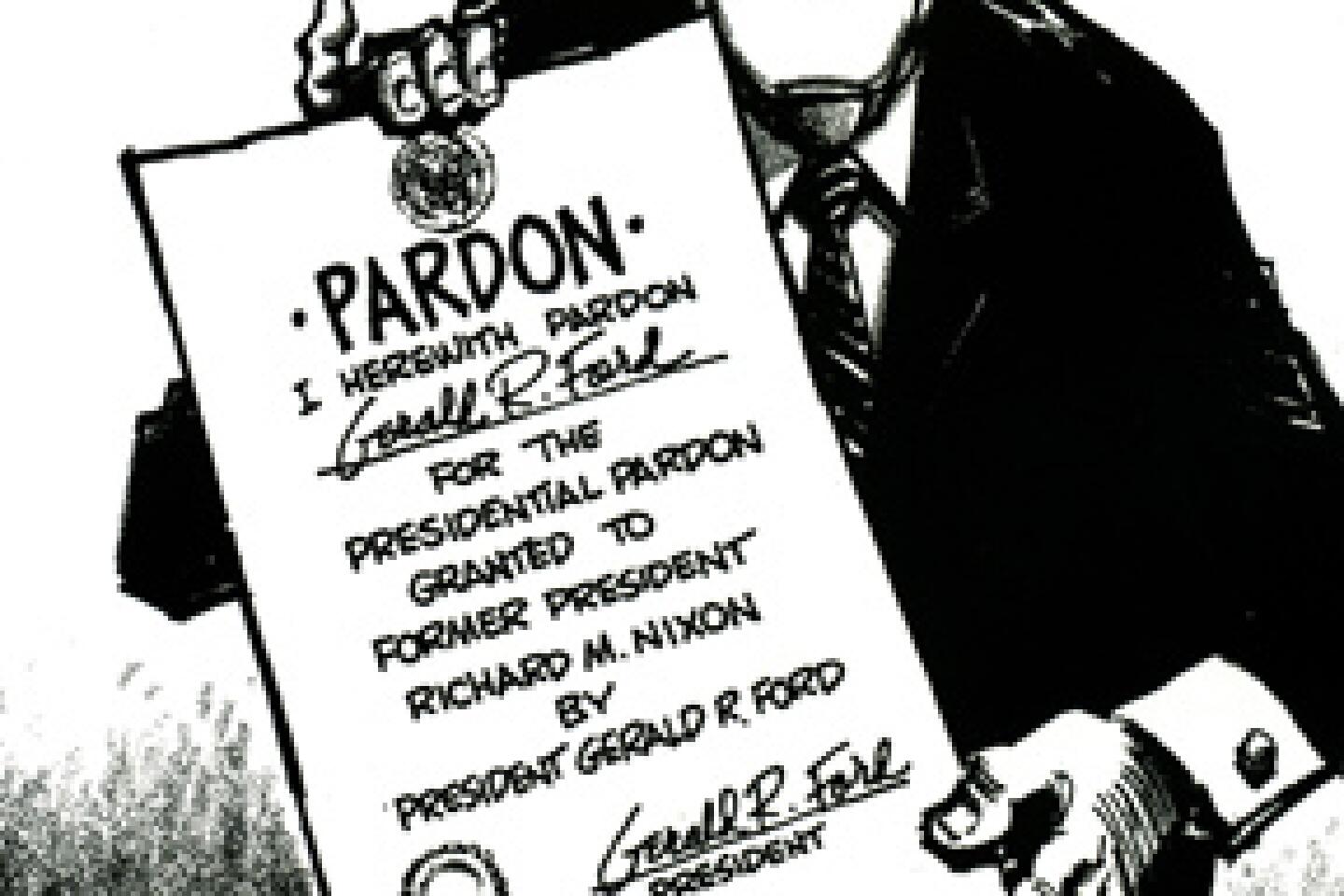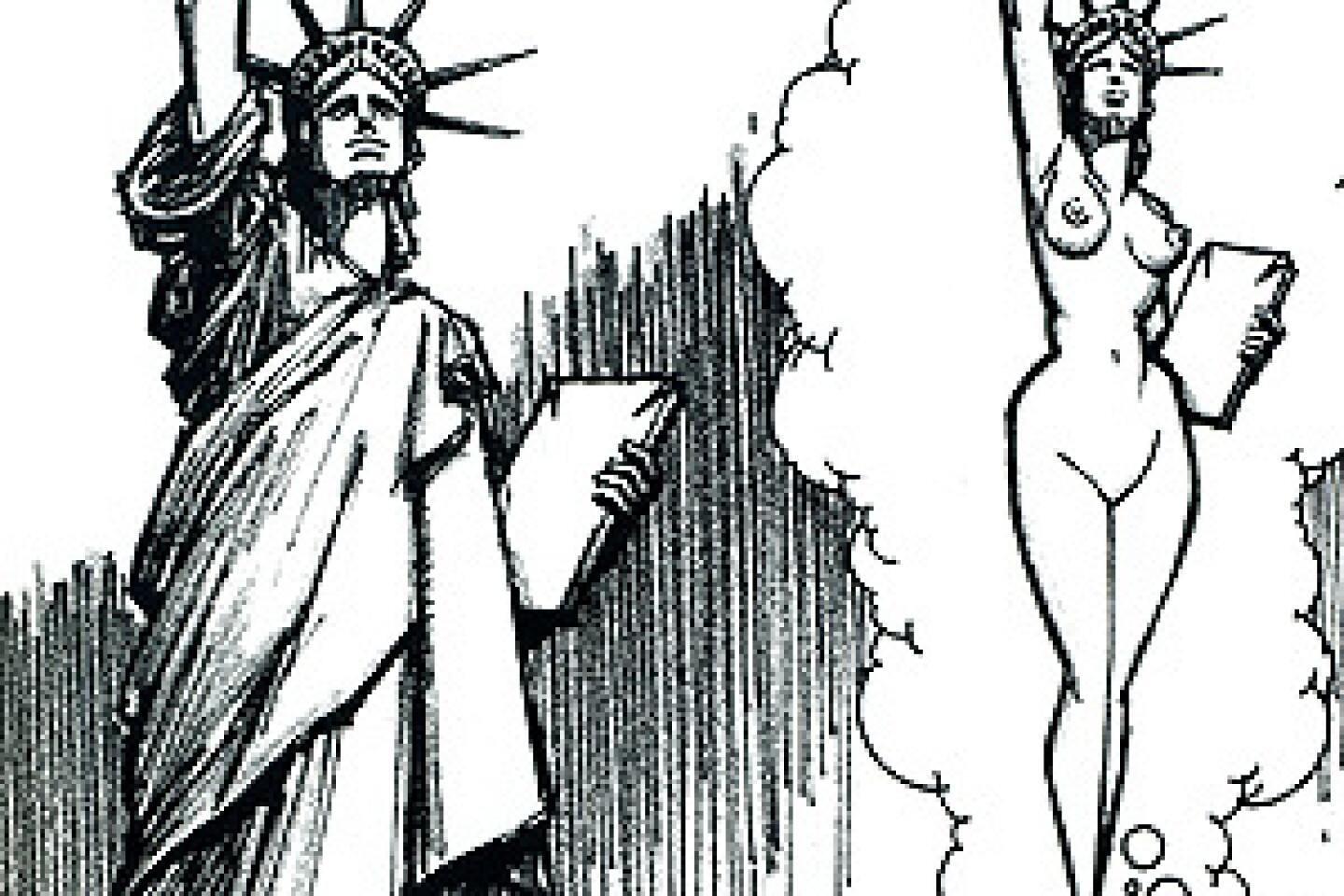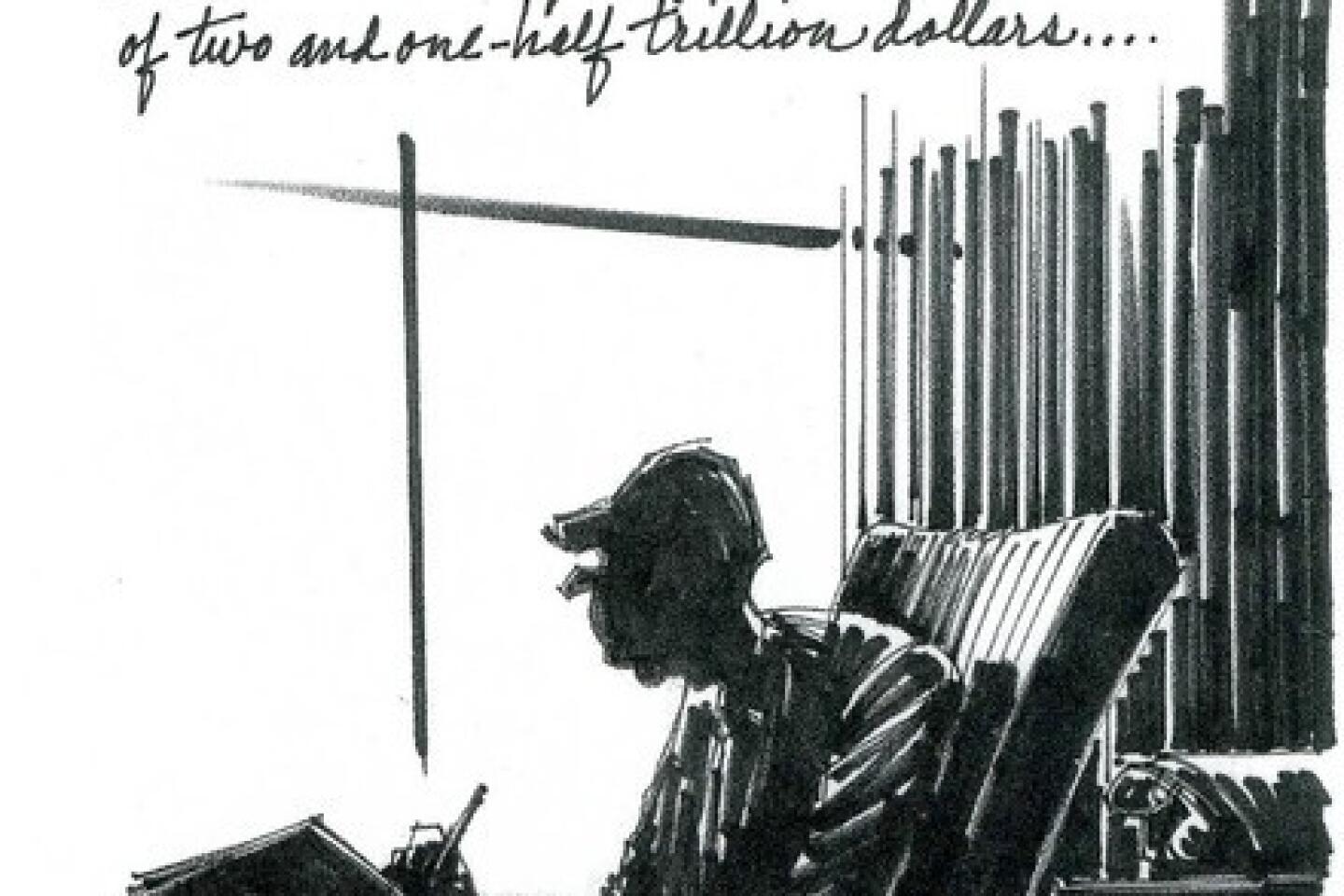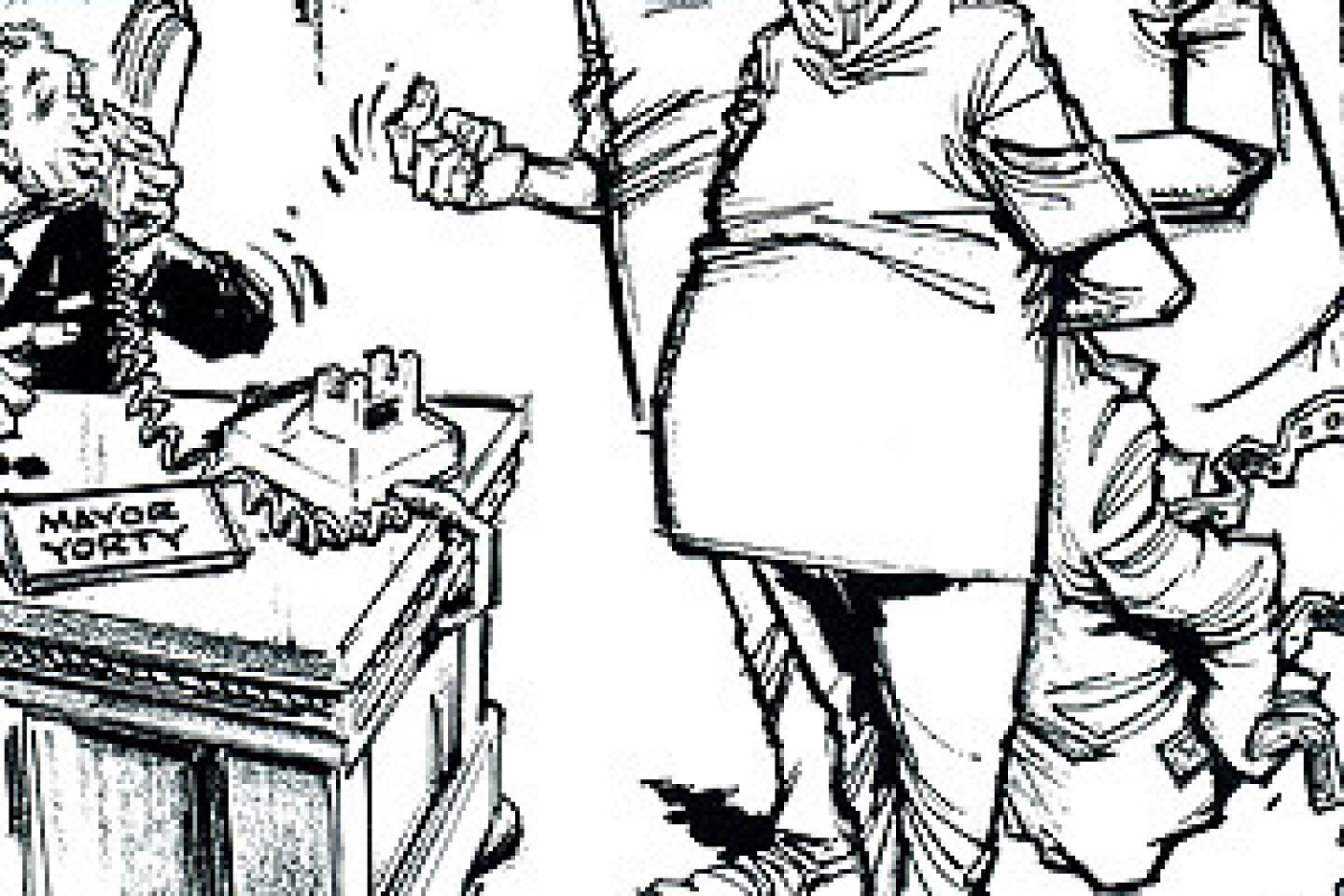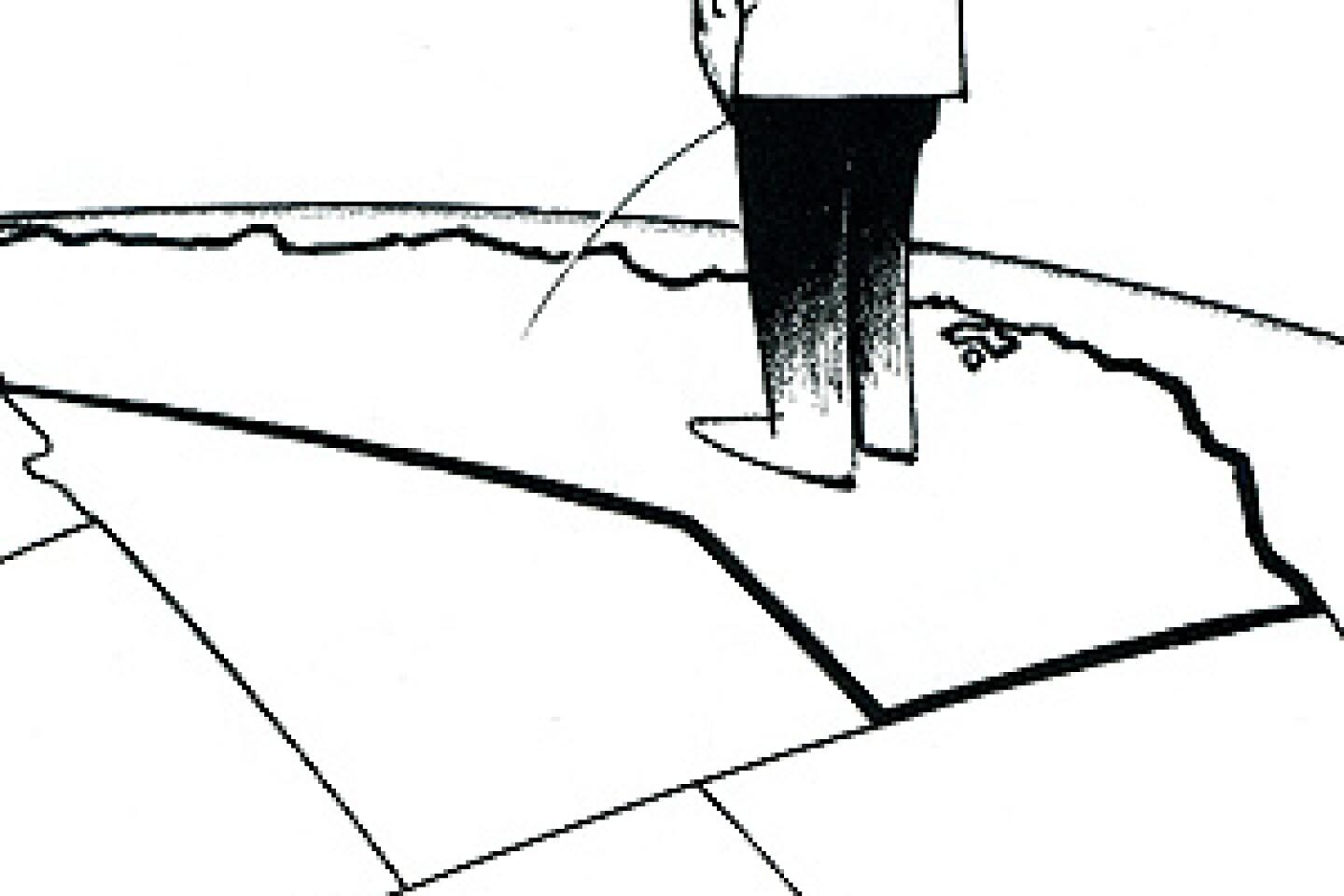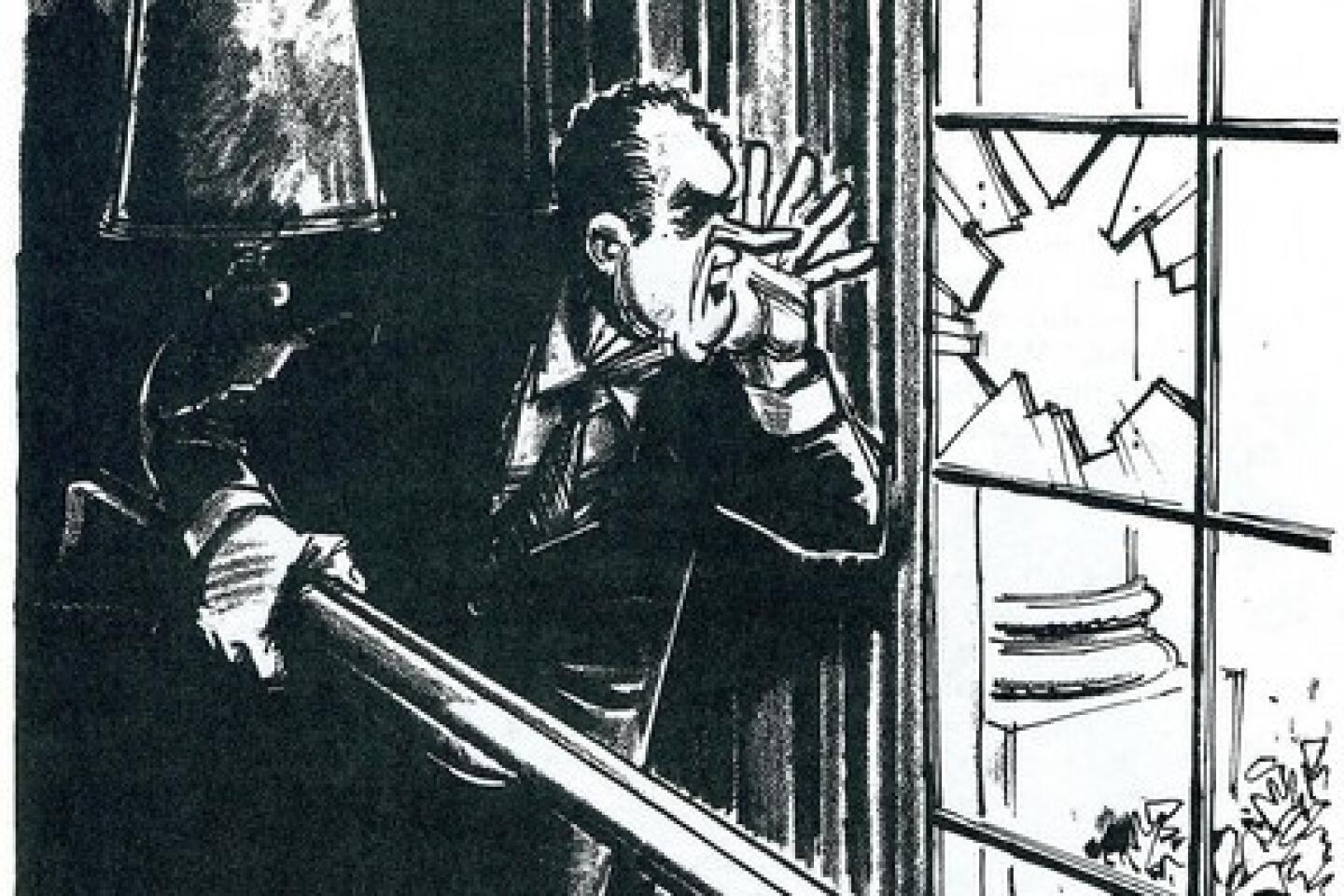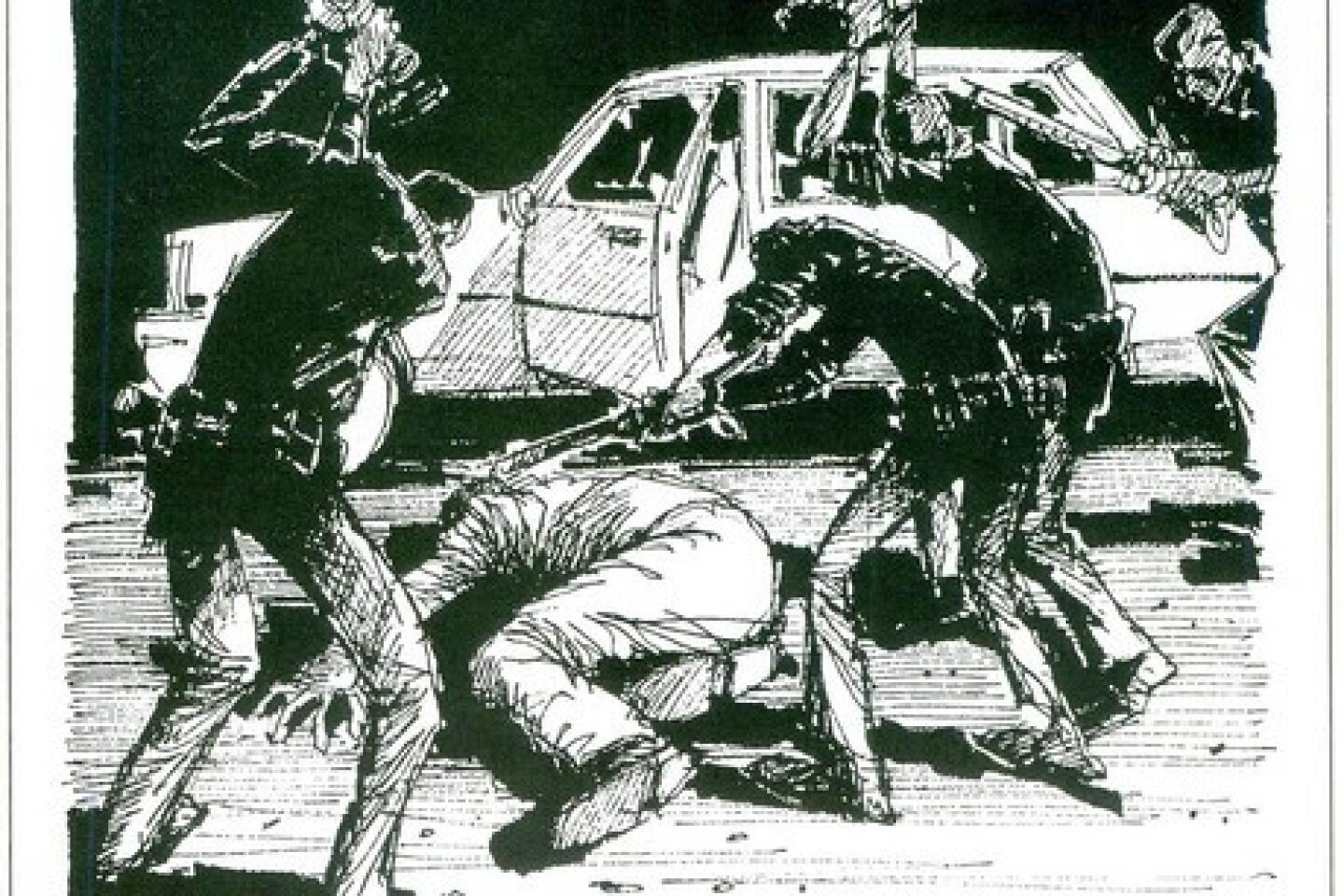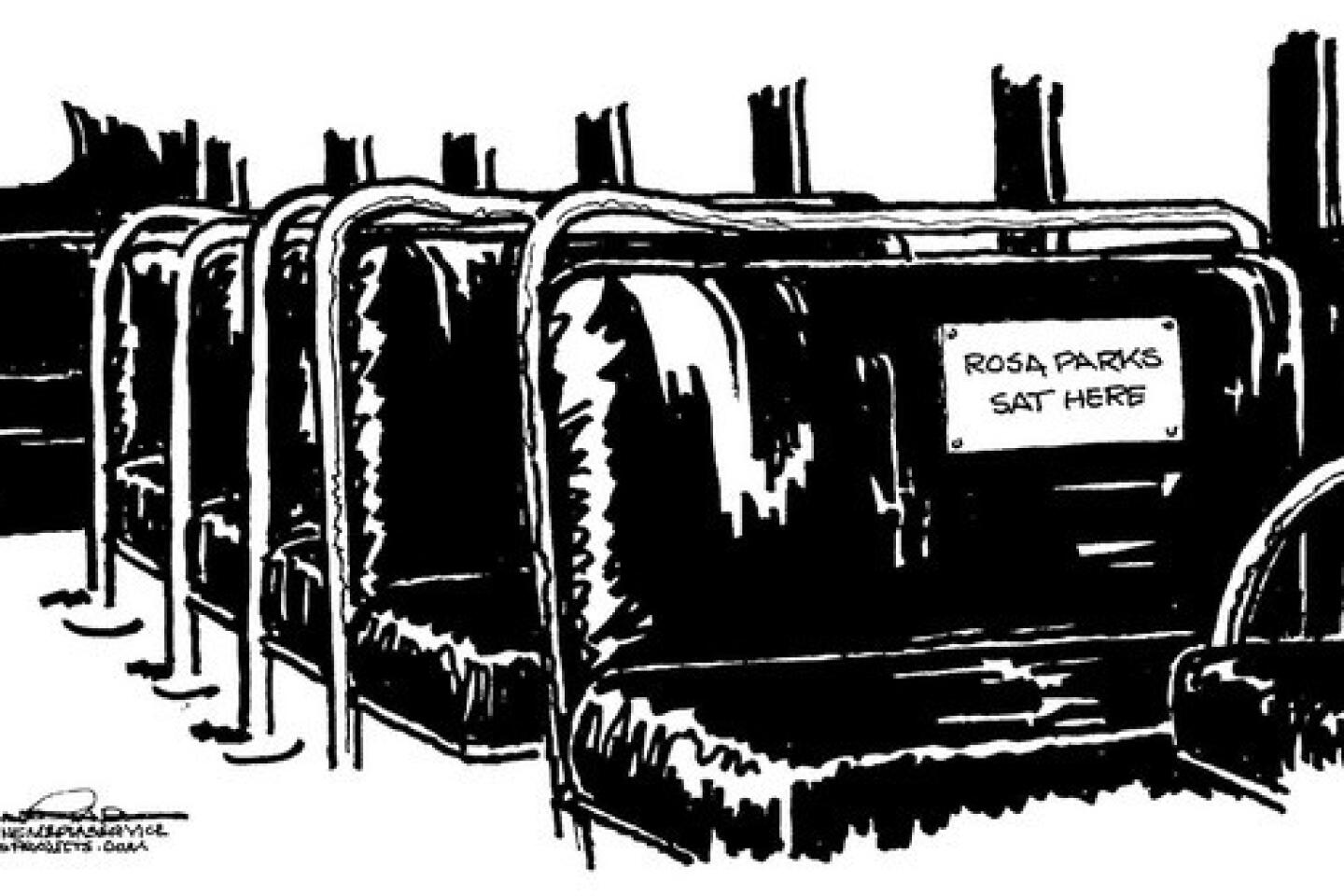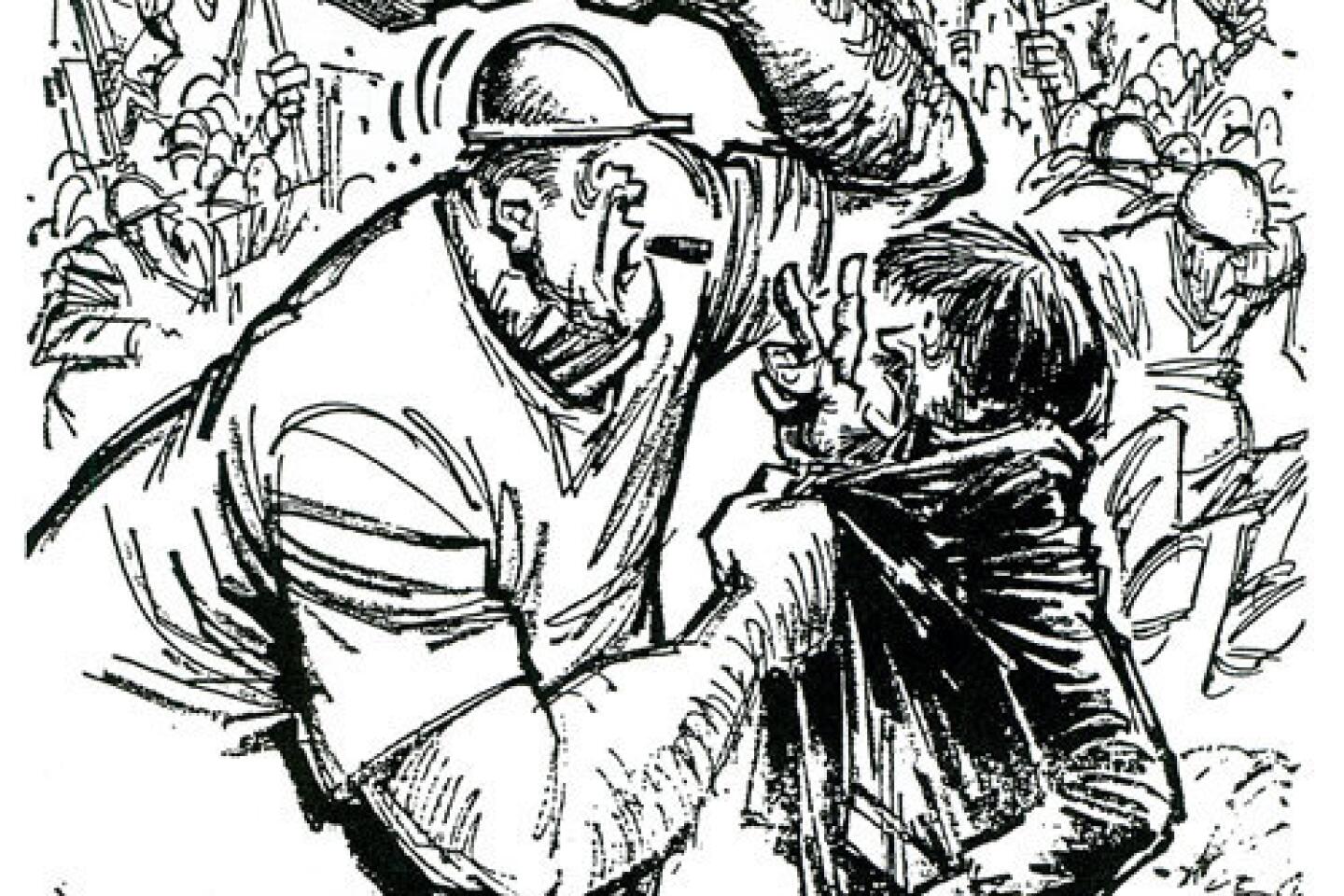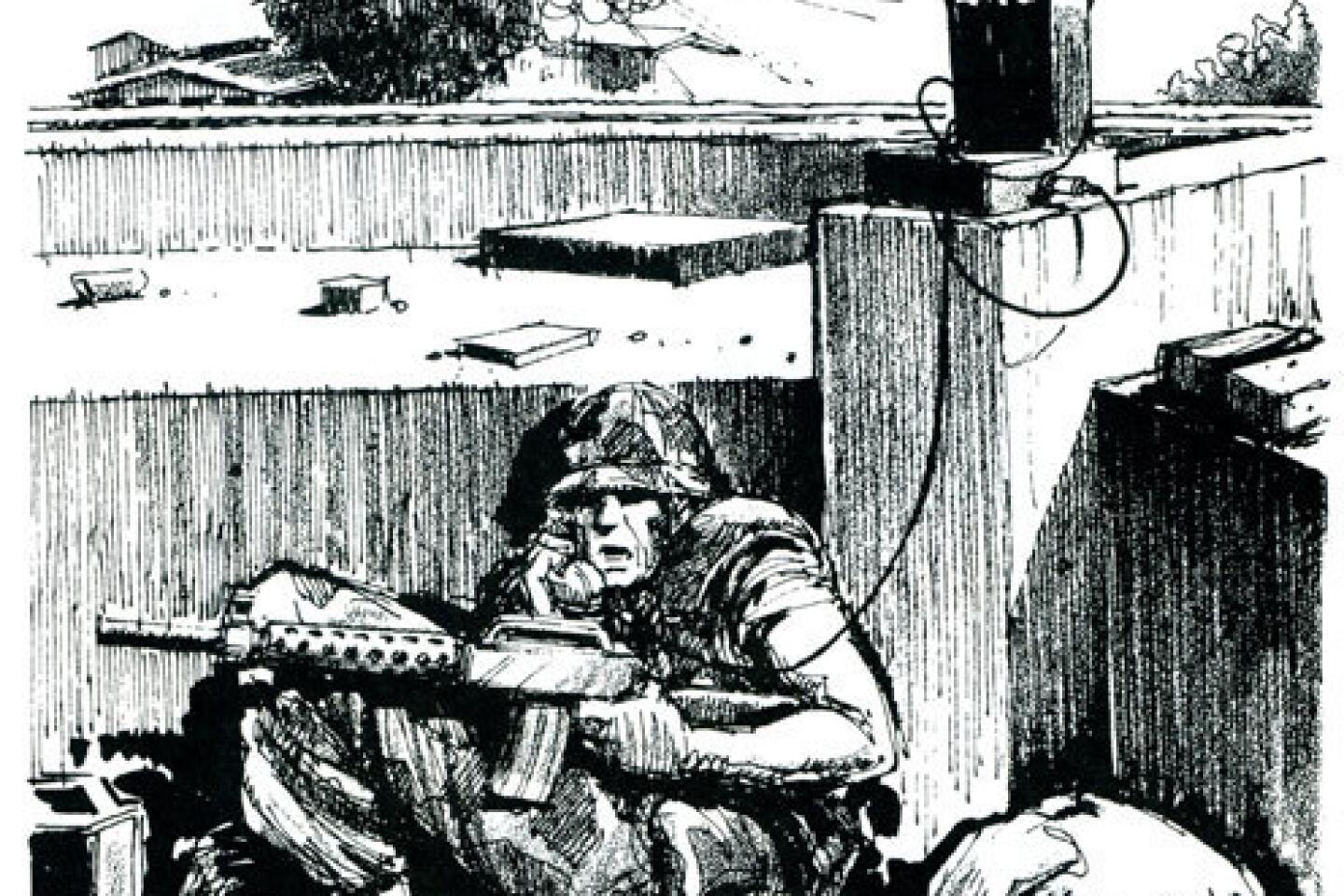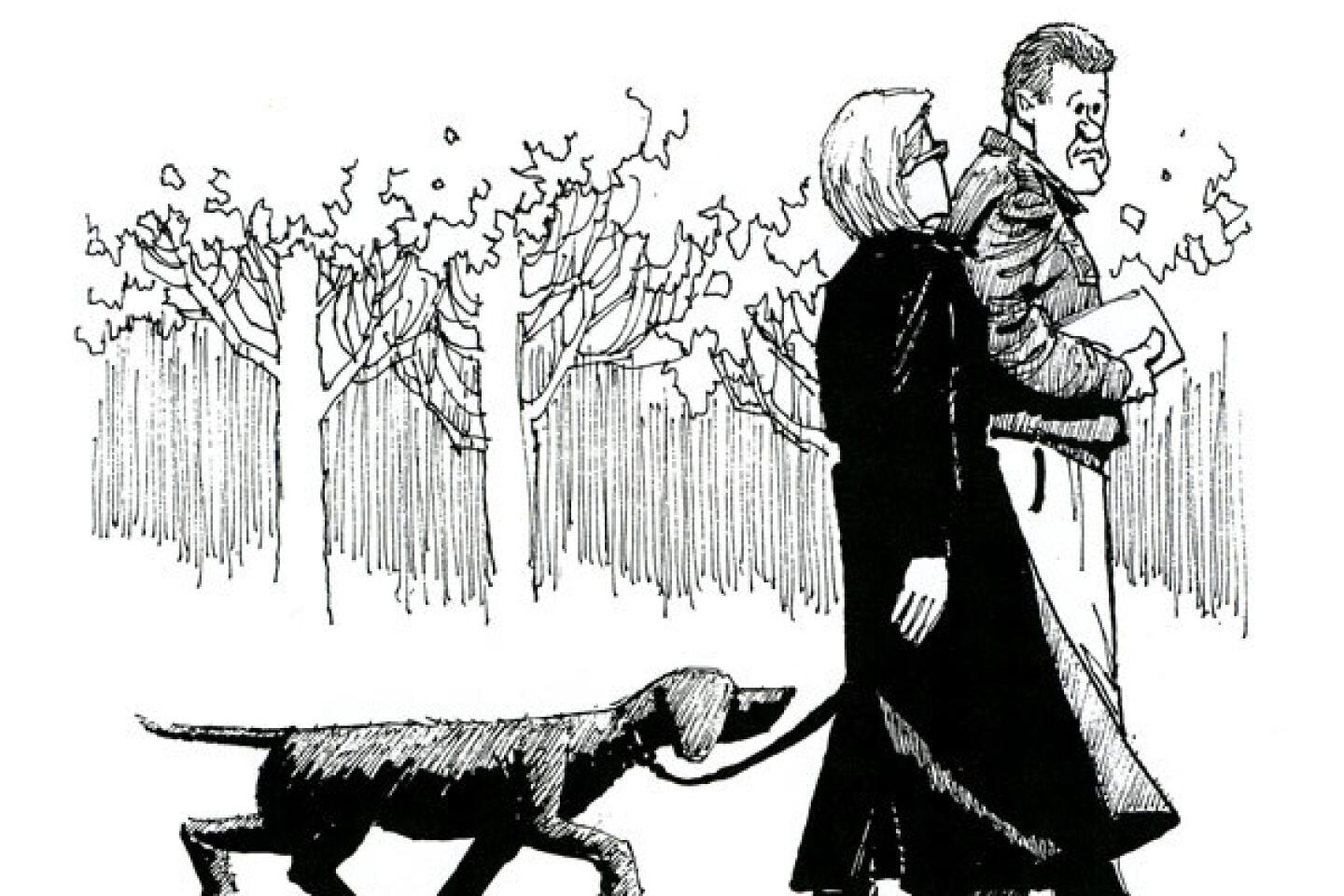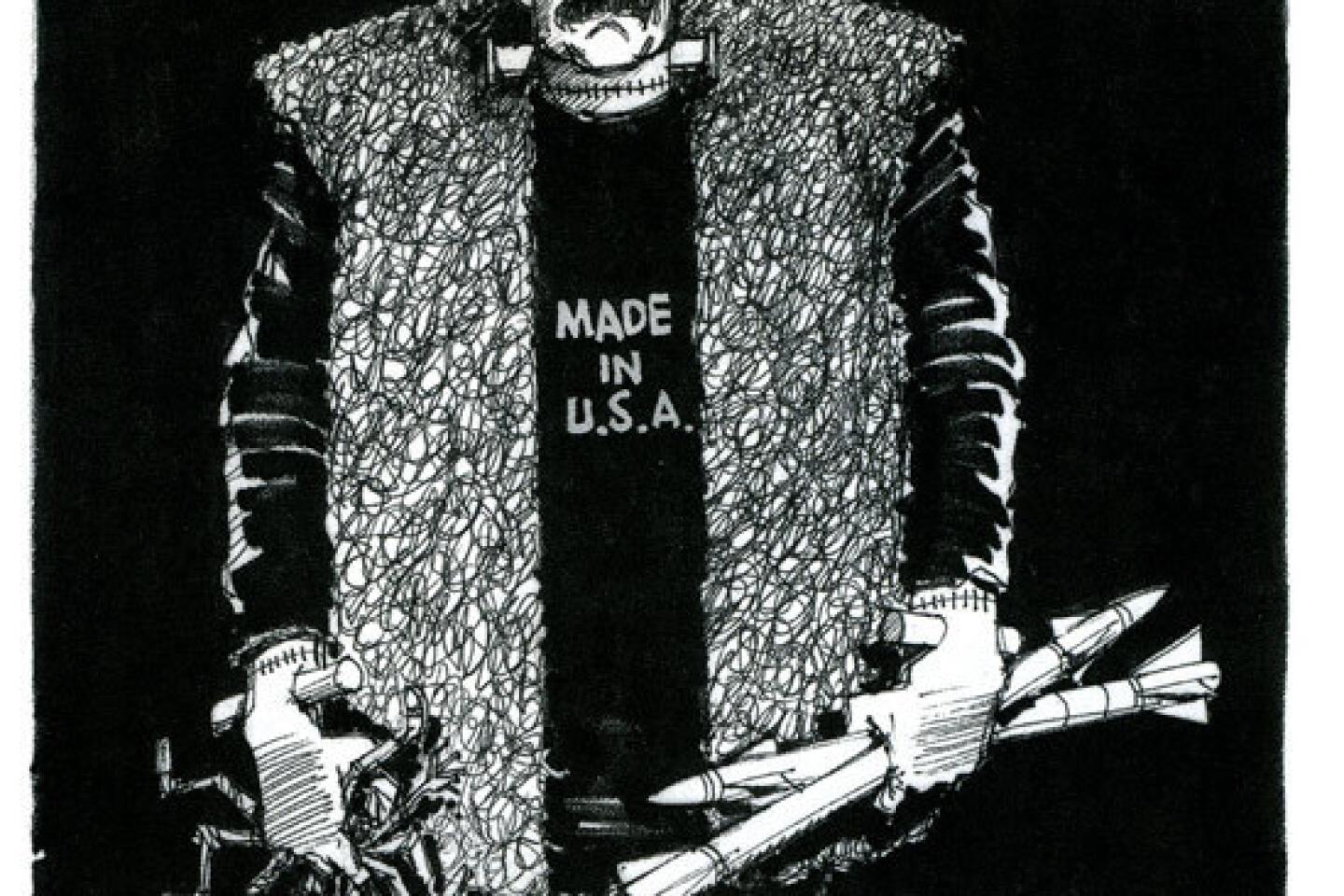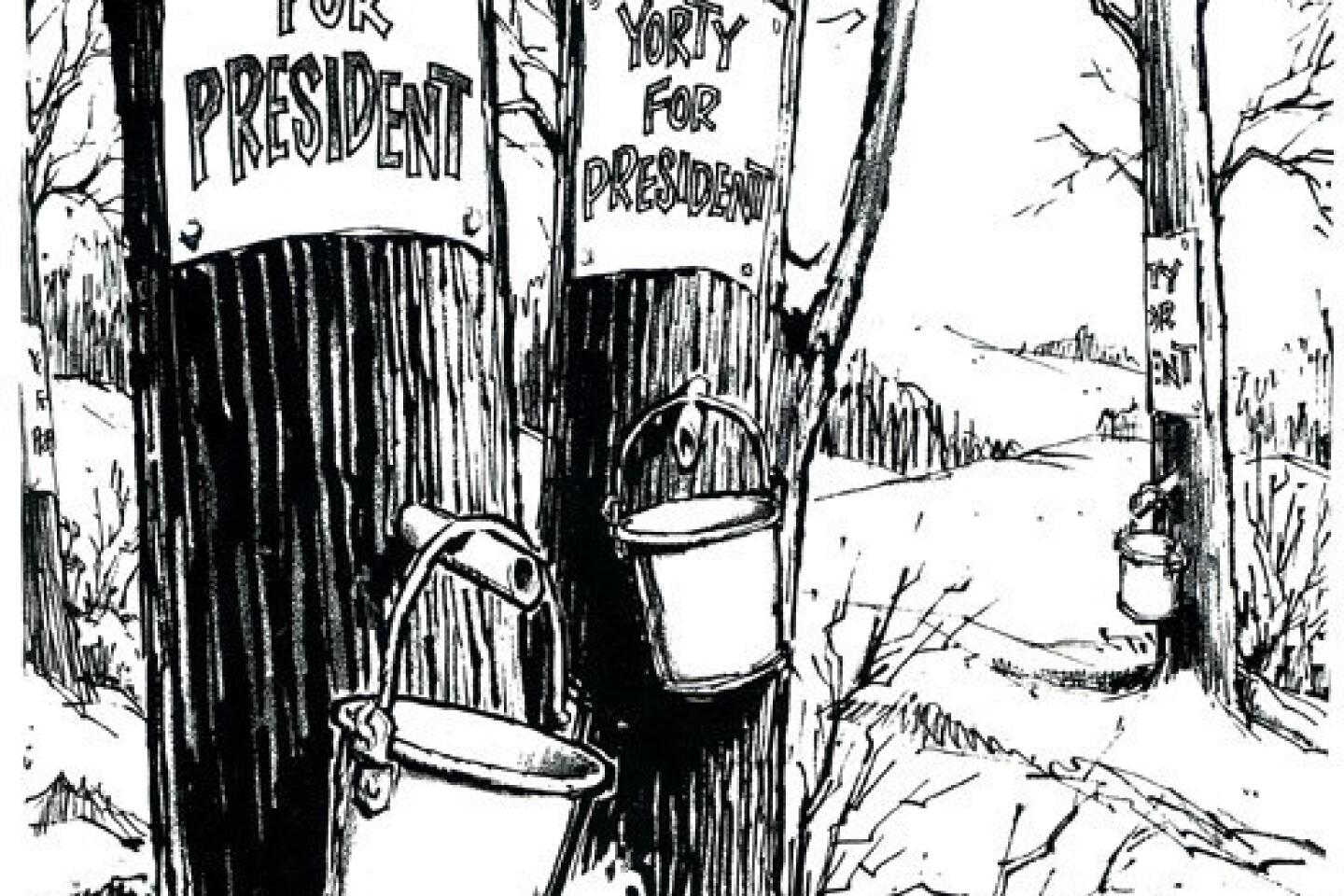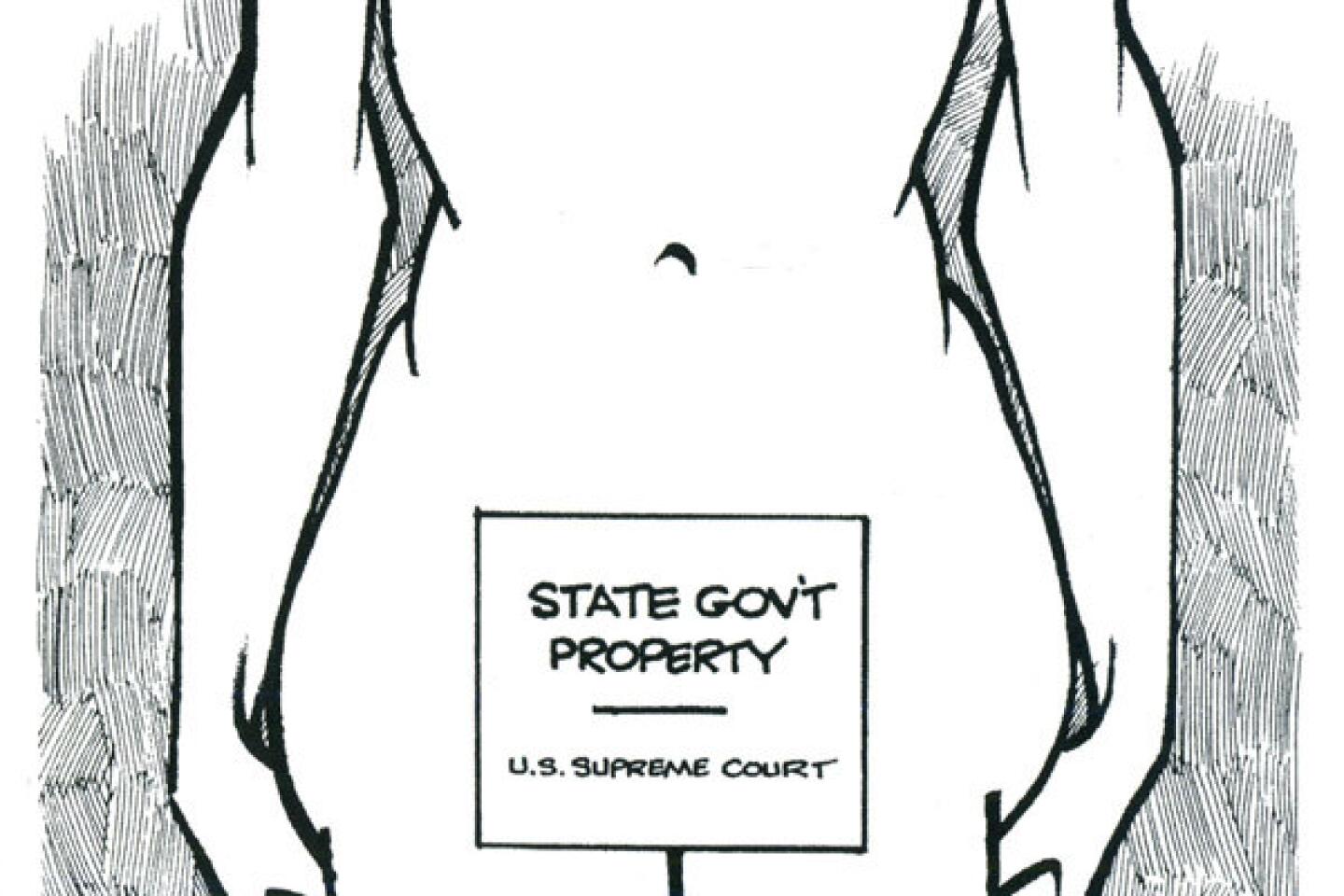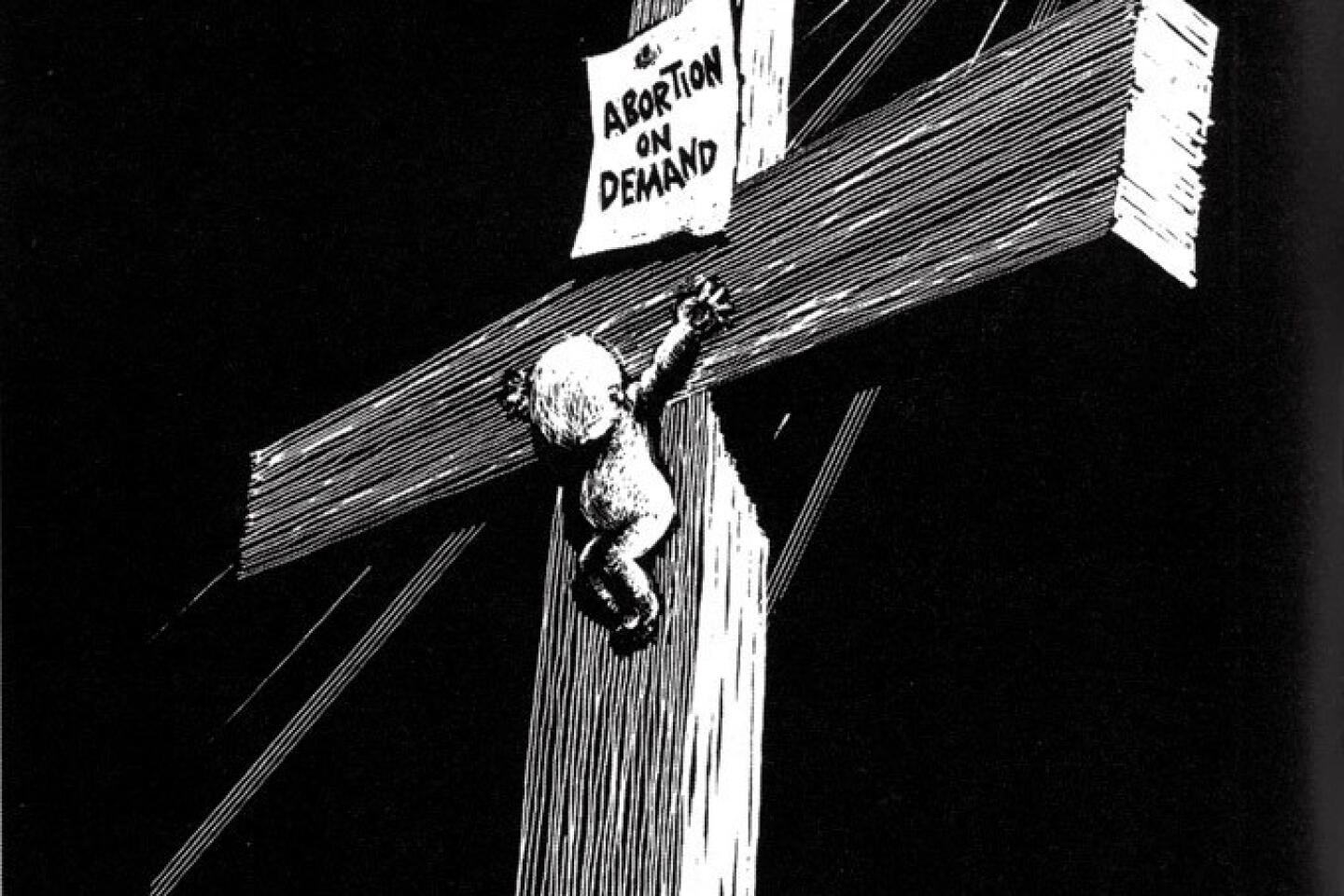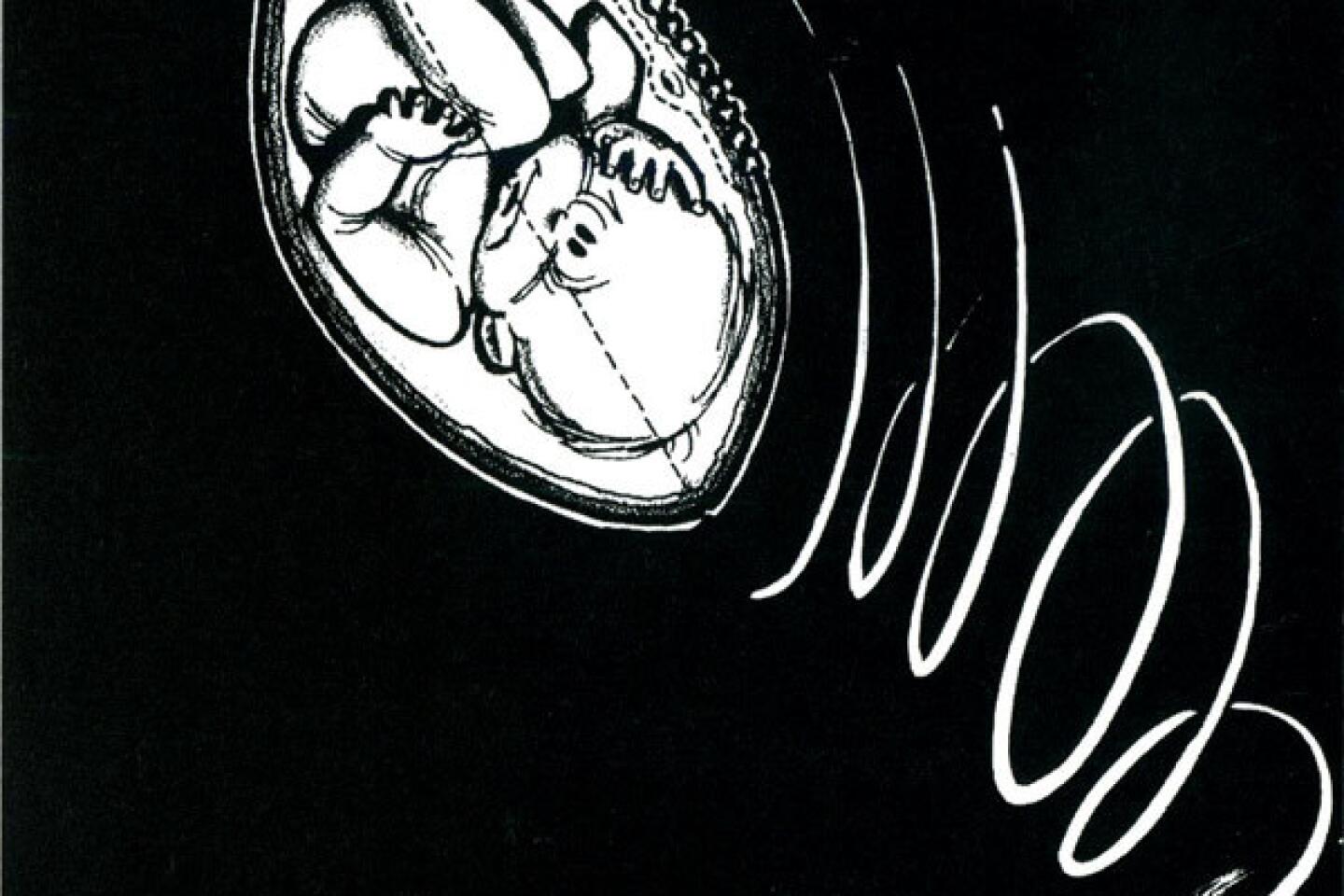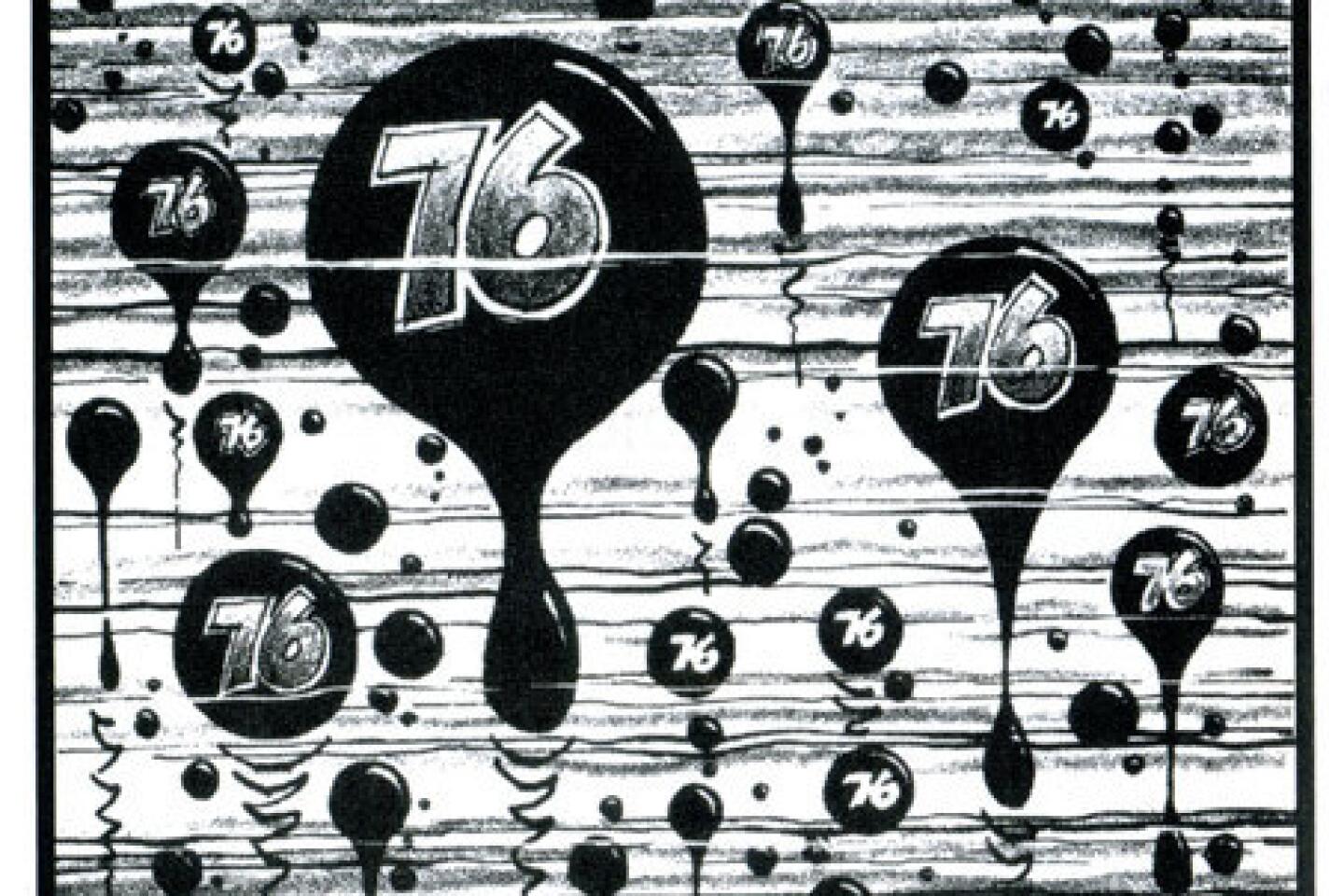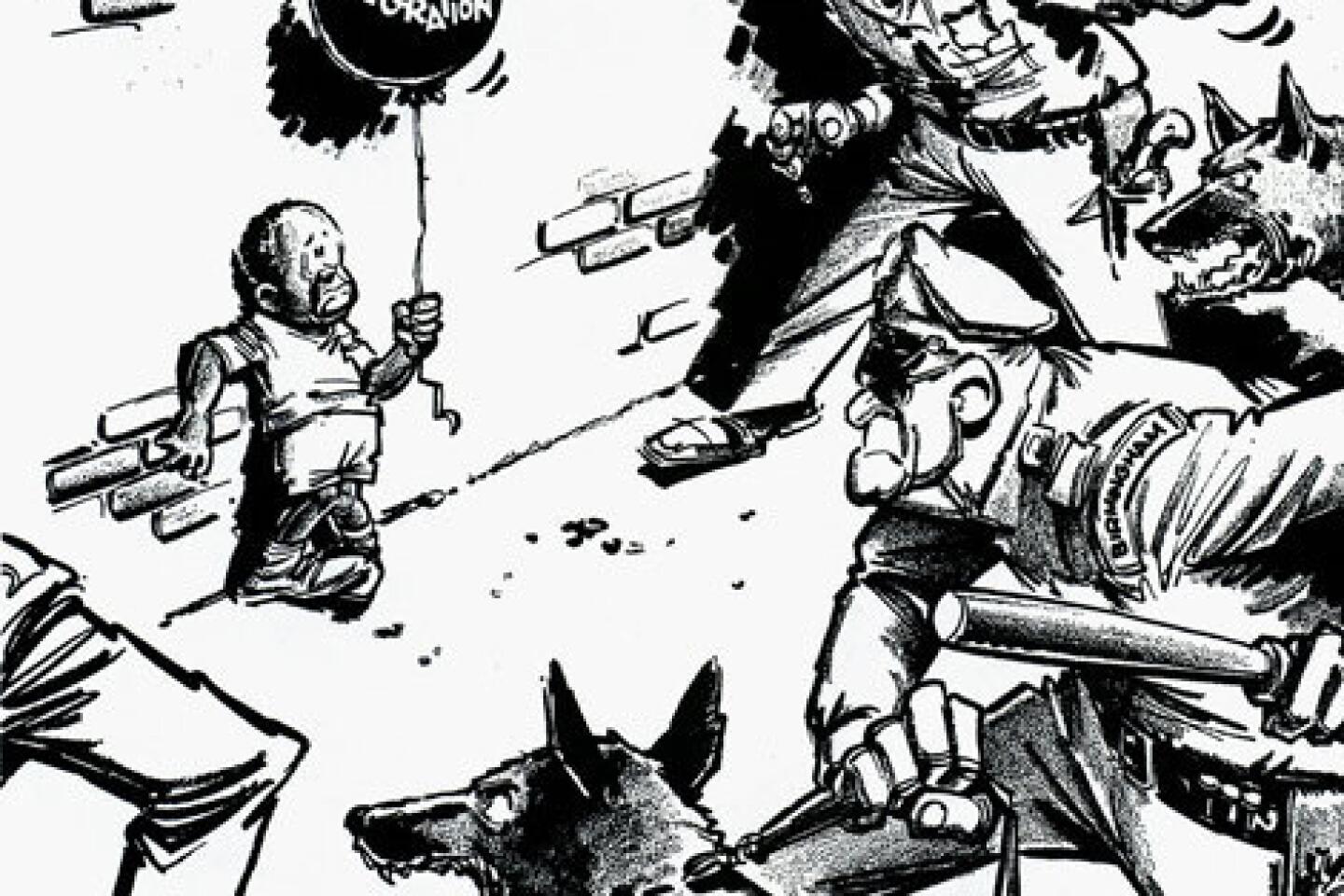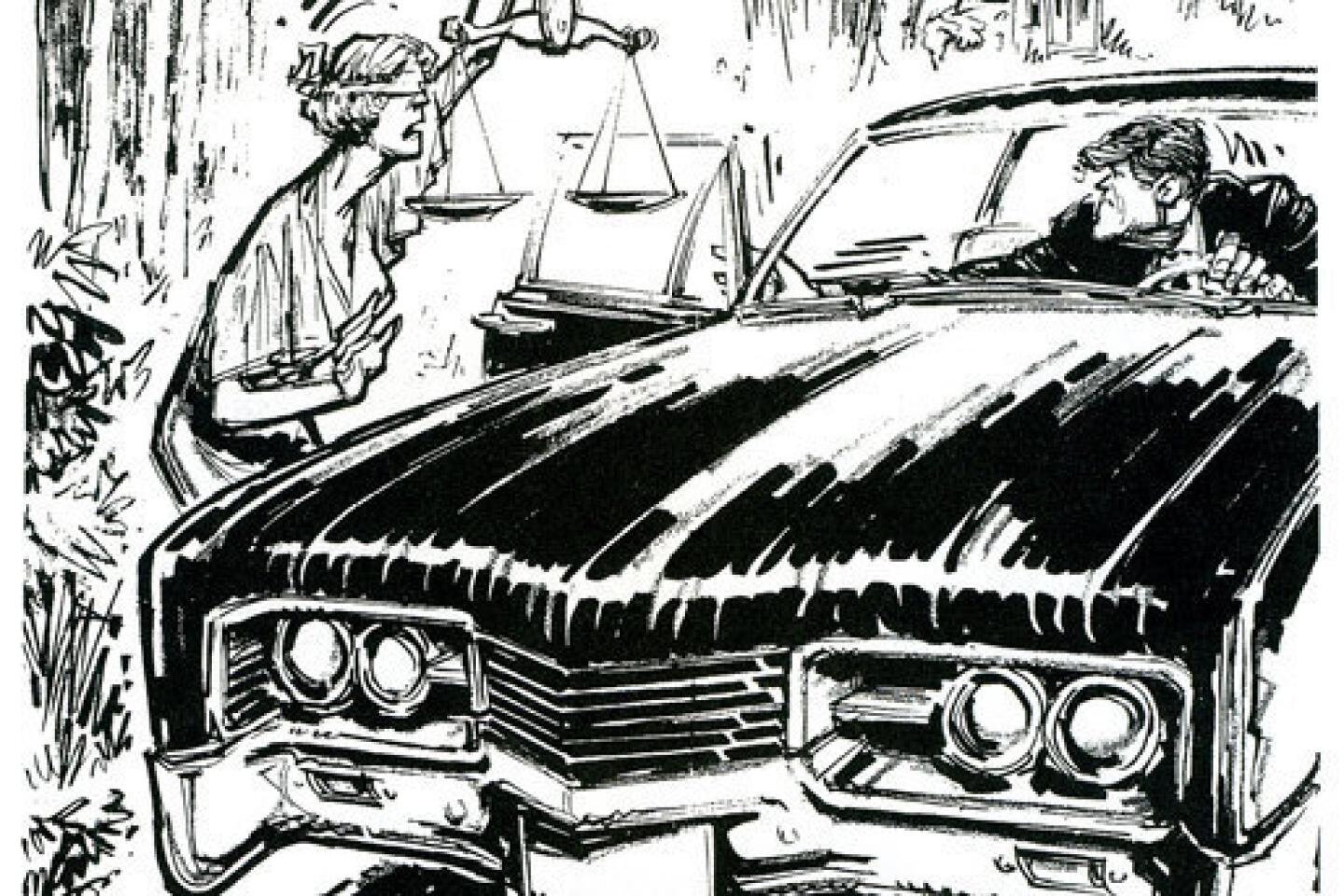Paul Conrad dies at 86; Pulitzer Prize-winning political cartoonist helped bring The Times to national prominence
Paul Conrad, whose fiercely confrontational editorial cartoons made him one of the leading political provocateurs of the second half of the 20th century and who helped push the Los Angeles Times to national prominence, has died. He was 86.
Conrad died early Saturday of natural causes, surrounded by his family at his home in Rancho Palos Verdes, said his son David.
With an unyielding liberal stance rendered in savage black and white, Conrad both thrilled and infuriated readers for more than 50 years. He won three Pulitzer Prizes, a feat matched by only two other cartoonists in the post- World War II era.
Mayors, governors and presidents cringed at the prospect of being on the business end of Conrad’s searing pen, while many Southern Californians made him their first stop as they sifted through The Times, the newspaper that was his principal home for nearly 30 years.
“When it comes to editorial cartooning, I am unabashedly biased: Paul Conrad was simply the best ever,” Times Editor Russ Stanton said Saturday. “Whether or not you agreed with his politics, readers waited every morning for his dose of political commentary, guaranteed to make them either angry, to think or to laugh. And his work inspired other cartoonists and writers to speak truth to power. The Los Angeles Times was fortunate to be part of his long and prolific career, and we have missed him since the day he retired.”
While many other cartoonists angled for whimsy or the easy one-off, Conrad “specialized in hair shirts and jeremiads and harpoons to the heart,” former Times Editor Shelby Coffey III once wrote. The cartoonist, loud and often profane in person, viewed himself as a champion of the common man and relished combat with those he saw as protectors of the rich and privileged.
His most prominent and enduring foils came in the person of two California politicians who rose to the presidency, Richard Nixon and Ronald Reagan. The scandal-plagued Nixon named Conrad to his “enemies list” — a designation the cartoonist described as one of his greatest honors. Former Times Publisher Otis Chandler became accustomed to his breakfast being interrupted by either Reagan or wife Nancy, furious that the then-governor had been depicted, again, as dimwitted, mean-spirited or out of touch.
“Conrad is ... more than a legend in cartooning and an institution in American journalism,” the late Doug Marlette, one of the many cartoonists inspired by that work, once said. “He is a force of nature….You measure Conrad on the Richter scale.”
The author and essayist Pete Hamill called Conrad “a voice. And the voice is his alone: alternately savage, compassionate, brutal and ironic.”
Conrad rose to prominence in a post-World War II era when many newspapers were at the height of their power and when he and other widely syndicated editorial cartoonists — including Herbert L. Block (Herblock), Bill Mauldin and Pat Oliphant — held a particular grip on the American psyche.
By the time of his death, the ranks of those dedicated to regular editorial cartooning had slumped below 90 from a high in the 1980s estimated, variously, at 150 to 200.
Just before his death in 2007, the onetime editor of The Times’ editorial pages, Anthony Day, worried that the skittish and contracting newspaper industry would no longer support a “genius” like Conrad. “It’s easier to not make trouble,” Day said, “than to make trouble.”
And Conrad loved making trouble. His righteous indignation was guided by a modest Midwestern upbringing, an abiding Catholic faith and what one chronicler called a “fanatic heart.”
Many journalists like to talk of the imperative of afflicting the comfortable and comforting the afflicted. Conrad embraced the credo with abandon. “Don’t ever accuse me,” he liked to say, “of being objective.”
An exceptional single-mindedness made many of Conrad’s cartoons jump off the page: Nixon, tied down like the giant, Gulliver, by reel after reel of his secret Oval Office audiotapes. Nancy Reagan’s pricey new White House china captures the reflection of a stooped homeless woman, picking through the trash. President Carter “lusts after” a voluptuous nude Statue of Liberty. A Northern Californian, opposed to the massive Peripheral Canal water project, urinates on a map of Southern California.
Another elder statesman of the cartooning trade, Oliphant, once said that his friendly rival exhibited “the grandest example of consistently A-grade, blue-ribbon, USDA-prime righteous anger that I can ever remember seeing in a cartoonist’s work in the 50-plus years that I have been doing this sort of thing.”
Paul Francis Conrad was born June 27, 1924, in Cedar Rapids, Iowa, along with an identical twin brother, James. They had an older brother, Robert. The boys recalled their mother as frugal but determined to introduce them to the arts. Their father, Robert Conrad, tended freight schedules for the railroad, sometimes skipping lunch to save for toys or piano lessons for his boys.
The elder Conrad dabbled in art, painting landscapes, but found little market for his work in Depression-era Iowa. He channeled his passion to his twins, urging them to draw on the back of the freight “rate cards” that he brought home from work.
Paul later quipped that his cartooning career began with a drawing scrawled on the restroom wall at St. Augustin Elementary School in Des Moines. At age 8.
“I learned that a picture is worth a thousand words,” Conrad wrote, “and that, when the Establishment gets mad, they always go after the cartoonist, not the editorial writers.”
He and brother Jim skipped their high school graduation and ran off to Alaska to work on the Alaska-Canadian Highway. World War II was raging by the time the Conrad twins returned to Iowa for the winter. Contacted by their draft board, they decided to enlist. Paul joined the Army Corps of Engineers and drove a truck during his time in the Pacific, which included the invasions of Guam and Okinawa.
Despite viewing World War II as the last “good” war, Conrad was deeply disturbed by the death and mutilation he saw around him. The experience would charge his opposition to the wars that would follow.
When he returned home to Iowa, Conrad didn’t have a clue what to do with his life.
He enrolled at Iowa State University but spent so much time traveling as the bass player in a big band that he flunked out. He got his brother to transfer with him to the University of Iowa, where Conrad majored in art.
An old family friend from Des Moines, Charlie Carroll, who edited the student newspaper, asked Conrad if he would consider drawing cartoons.
“I wasn’t very good,” Conrad recalled. “But Charlie took me over to see that first cartoon come off the press, a Franklin flatbed. And there it was, my cartoon! God, it was exciting! Just marvelous.”
The young artist soon worked up to six cartoons a week, drawing on a range of topics, including national and international news. He had found a calling.
In his first professional job, at the Denver Post, Conrad got the sort of support that would sustain him through his long career. Editor Palmer Hoyt allowed his young protégé to experiment and take chances.
Conrad also met and began courting the newspaper’s new society writer, Kay King. She briefly dated Conrad’s brother, but Jim persuaded Paul and Kay that the two of them were a match.
Their marriage provided Conrad with his most important and enduring advocate, editor and critic. Many others would offer advice or suggestions, but the cartoonist once said that only Kay Conrad and Edwin O. Guthman, The Times’ national editor, could persuade him to kill an idea he had been set on.
Guthman had worked as an aide to U.S. Atty. Gen. Robert F. Kennedy before becoming The Times’ national editor in 1965. He shared Conrad’s liberal sensibility but was also willing to say when the cartoonist had missed the mark.
During his 14 years in Denver, Conrad honed what became his distinctive style: spare images, urgently drawn. Peers began to recognize his superior draftsmanship and discipline, resisting superfluous ornamentation. When inking a cartoon, Conrad would caution himself: “One more stroke and you’ll ruin it, Con.”
He believed the perfect cartoon had little or no text. To represent President Nixon’s self-inflicted wound from his Oval Office taping system: an unraveled audiotape, formed into a hangman’s noose. Depicting hawkish U.S. foreign policy: a beaming Reagan, sitting waist-deep in a bathtub filled with toy warships.
“His lines were very bold and strong and it conveyed to me that he was certain of what he believed,” said John Sherffius, who grew up in Los Angeles watching Conrad and now cartoons for the Boulder (Colo.) Daily Camera and other papers. “His message jumped out at you, almost like a stamp. He was saying ‘Here it is. Now make up your own mind.’”
In the early 1960s, The Times was just beginning to rouse itself from decades of mediocrity. The newspaper had been politically and economically dominant in Southern California but a laughingstock in most of the country because of its mediocre journalism and blatant Republican boosterism.
Otis Chandler took control as publisher in 1960 and, with Editor Nick Williams, decided to hire top talent to lift the paper to a higher level.
The duo, determined to bring Conrad to Los Angeles, impressed him with their resolve. “The one thing I said,” Conrad recalled, “was, ‘Nobody tells me what to draw.’”
The arrival of Conrad jarred many Times readers, not least the ultra-conservative members of the extended Chandler family, who already were displeased that their more liberal cousin, Otis, had taken control of the family business.
“Nick [Williams] saw that Paul was this strident and very dedicated liberal and Nick thought that I would take a real beating, which I did,” Chandler said in a 2006 PBS documentary about the cartoonist. “But it was worth it, because he’s a real genius. He brought enormous credibility and prestige to The Times.”
In his first years at The Times, Conrad focused with particular fervor on the civil rights movement. In one image, a black soldier stuck in a foxhole in Vietnam holds his head in despair, reading news of African American marchers beaten by police back home in Selma, Ala. In another, a group of middle-aged white men put a black man on the therapist’s couch after the 1965 Watts riots and prod: “You’ve mentioned unemployment, housing, education, police brutality and despair ... but, what was the reason for the riot?”
More than a few of his cartoons reflected Conrad’s strong Catholic faith: One potent antipoverty image in 1968 showed an African American baby curled on a filthy mattress in a dilapidated apartment, with the message: “Ye shall find the babe wrapped in swaddling clothes, lying in a manger.”
True to form, Conrad was not unquestioning of his faith. When Pope Paul VI wrote against the ordination of women in 1977, Conrad strongly disagreed, particularly with the argument that priests must be in Christ’s image. The cartoonist drew the pope, instead, holding a baby in his own image: bald, big-eared and bespectacled.
Los Angeles Cardinal Timothy Manning wrote Conrad that the cartoon was “offensive and a scandal.” But rather than “undo the affront,” as the cardinal demanded, Conrad fired off a letter suggesting that the cardinal had missed the point. The commonality of the human soul was much more important, Conrad argued, than physical similarity.
Conrad saw his role as reducing the complicated public questions of the day to one essential, powerful truth. “Editorial cartoonists are idealists, of another world,” he said in the introduction to one of his seven books of cartoons. “Political, social and moral injustices are perceived as monstrosities” requiring the cartoonist to “sweep aside all the complexities and go to the basic issue; to take suspicions, coincidences and past events and record them larger than life.”
The cartoonist reveled in goading elected officials he believed had forgotten the source of their power. He jousted with 11 presidents, beginning with Harry Truman, but took particular delight in skewering Nixon.
The Watergate scandal created a perfect convergence — Nixon’s scheming and skullduggery pitted against Conrad’s righteous indignation and furious craft. From the day after the illegal break-in — when he drew Nixon disguised as a phone company worker boring a hole in the wall at the Democratic National Committee headquarters — the cartoonist relentlessly pursued the wounded president.
Conrad rendered Nixon with brow furrowed, eyes ringed with dark shadows, head slumped into rounded shoulders — helping to cement the image of a desperate, paranoid chief executive. “His own worst enemy,” said one cartoon of the glowering president, hunkered over his enemies list.
Others saw Nixon’s 1994 death as occasion for absolution. Not Conrad. He drew the 37th president’s grave with the words: “Here lies Richard Nixon.” Of the glowing postmortems, Conrad pronounced: “I think it’s sick. We know what the bastard did.”
Conrad’s contest with Reagan had an even longer run — beginning when the former actor was elected governor of California in 1966. In contrast to the dark and menacing Nixon, the cartoonist often portrayed Reagan as a buffoon, the “B” movie actor miscast as a statesman.
Then-Gov. Reagan would phone in his complaints early — interrupting Chandler at breakfast, according to author and historian David Halberstam. The Times publisher stopped taking the calls, only to have Nancy Reagan take up the attempt to stifle Conrad’s pen. But the future first lady soon gave up, realizing Conrad had no intention of granting a cease-fire.
More than a decade later, Conrad continued to strafe Reagan — particularly disparaging his military buildup and social-program cuts as president. He drew Reagan bequeathing a $2.5-trillion federal debt to “our children, and to their children and to their children’s children.”
Although an unflinching partisan who swore he would never vote for a Republican, Conrad did not spare the Democrats. One image from the 1970s shows Lady Justice turning down a ride in a convertible with Sen. Edward M. Kennedy, after the scandalous car crash at Chappaquiddick that killed a young aide.
The philandering President Clinton also took his share of punches, including a cartoon in which Hillary Rodham Clinton wonders aloud if the president should be neutered, along with the family dog.
Liberal true believers saw Conrad as their muse. Many taped their favorite Conrads to their refrigerators. But even his biggest fans came to understand that the cartoonist could not be pigeonholed and that he probably wouldn’t bend to make them happy.
His frequently tough assessments of Israel brought particular condemnation.
Conrad depicted Palestinians as the new lost tribe of the Mideast. When hundreds were slain in Palestinian refugee camps in the early 1980s, he drew a Star of David formed by the bodies of dead men, women and children.
“We had a hell of a time with the Jewish community. They came in delegations. It usually started out angry and sometimes became tearful,” said former Times Editor William F. Thomas. “They were so upset about how Israel was being portrayed.”
Conrad’s take on abortion also inflamed anger and outrage, from both sides of the emotional issue.
For much of his early career, his Catholic faith informed his unstinting opposition to terminated pregnancies. “Forgive them, Father, for they know not what they do ...” said a 1976 cartoon that showed a baby nailed to a cross. Not long after, the cartoonist explained: “Nobody can speak for the fetus. So, in that sense, I think the liberal stance should be against abortion.”
But by the late 1980s, his position had reversed. When the U.S. Supreme Court allowed states to have more say in abortions, Conrad drew a naked woman with a sign, “State Government Property,” posted over her womb.
His reassessment of abortion was the most dramatic about-face of Conrad’s career. “I thought, ‘You forgot all about the women on this thing,’” Conrad said years after he made the shift. “I thought, ‘You’ve been on this antiabortion thing too long. It’s time to get with it.’”
His fierce and unbridled commentary made Conrad — along with sports columnist Jim Murray and lifestyle columnist Jack Smith — one of The Times’ undisputed stars. It also provoked extreme passion among the newspaper’s readers.
“I want to thank you for your unflagging confrontation through the years — of the poseurs and killers, the greed-merchants and hypocrites, the militarists and elitists and all the others who would subvert our humanity and our divinity,” Cal State Long Beach English professor Robert J. Brophy wrote in 1990. “You make my days.”
Frank Sinatra had quite a different take when a cartoon poked fun at Reagan’s poor hearing. The singer wrote a letter to say he’d had more than enough of Conrad’s “viciousness and hatred.”
“He is a disgrace to responsible journalism,” Sinatra wrote. “And you all ought to be ashamed of yourselves for hiding behind the 1st Amendment, which was never intended for people like Conrad anyway.”
Other Conrad opponents took him to court.
Los Angeles Mayor Sam Yorty sued for libel in 1968. The cartoon in question chided Yorty for his ambition to be named Nixon’s secretary of Defense. In the image, Yorty tells a phone caller, “I’ve got to go now ... I’ve been appointed Secretary of Defense and the Secret Service men are here!” The men drawn waiting for the mayor are, instead, wearing white suits and carrying a straitjacket.
Yorty claimed that by raising doubts about his mental stability, Conrad had defamed him. But a Superior Court judge dismissed the case before trial and the mayor’s appeals failed.
It took considerably longer for The Times to fight off a suit, brought in 1974, by Union Oil Co. President Fred L. Hartley. Conrad had drawn a denuded Christmas tree with a single Union 76 bauble, along with the tag: “Merry Christmas from Fred Heartless.”
Hartley argued that he could not be held responsible for the government-ordered diversion of 500,000 barrels of oil from Southern California to Guam during the height of the oil crisis. The oil chief had previously had an amiable acquaintance with Conrad, even donating $200 to a Little League team the cartoonist coached. Hartley called the cartoon a “dastardly deed” that had damaged his health and held his family up to ridicule.
But a judge ruled Hartley was a public figure, meaning the executive could prove libel only if he showed that Conrad knowingly published a falsehood, with reckless disregard for the truth. By 11 to 1, a jury found that the oil executive did not meet that standard.
The courtroom victory only enhanced the image within The Times of Conrad as a towering, practically invulnerable figure. Even his physical presence seemed to confirm that view. Conrad stood 6 feet 2, his large head framed by thick, black-rimmed glasses and his arrival announced in a booming voice.
He would start each day at home reading the New York Times voraciously, then turn to the Los Angeles Times before punching on news radio on the way to The Times’ downtown offices.
He would spend the morning sketching out ideas on 8-by-11 newsprint “roughs,” puffing his ever-present pipe (even years after smoking was banned at the newspaper) and perhaps bellowing a barb at one of the editorial writers ensconced near his windowed office, a floor below the Times newsroom.
Conrad enjoyed give and take over his drafts, his co-workers said, but he could become ornery if a finished cartoon came under fire.
“He would think I was a stupid tool of the enemy, whoever the enemy was, and this feeling would just all sort of erupt,” said Day, the editorial page editor. “His middle name was ‘Difficult.’ But his middle name was also ‘Talented.’ Enormously talented.”
In the 30 years between his hiring and his 1993 retirement, his bosses killed only a handful of Conrad’s cartoons. After Nixon declared Charles Manson guilty of murder before a verdict had been rendered, Conrad drew a grinning Manson sporting a “Nixon’s the One” button. Day said it was in bad taste and axed it.
The Times killed two other cartoons that featured the naked rear ends of world leaders. One was of the presidents of the industrialized democracies and the other of Iraq’s Saddam Hussein, mooning the West before the Persian Gulf War. Conrad said: “I thought that last one was pretty funny, but ... . “
“Otis and I would sometimes kind of talk, kid around, about how much trouble Conrad was,” said former editor Thomas, who headed the paper’s editorial operations from 1971 to 1989. “We all caught hell for things, but you couldn’t help but appreciate the artistry that he had, the intellect behind it and the punch that it packed.”
It was at his home in Rancho Palos Verdes that Conrad escaped the pressure cooker of daily deadlines and political intrigues. He enjoyed a prosaic suburban existence, playing golf, coaching his two boys and two girls in baseball, softball and soccer.
“The funny thing was, there was Conrad, this acid, tough guy,” recalled friend and former Times City Editor Bill Boyarsky, “and then there was the Palos Verdes Conrad, very settled and into all this community stuff.”
Many of Conrad’s stalwarts — including Otis Chandler and his successor as publisher, Tom Johnson — had left The Times by the early 1990s. The cartoonist would say later that he felt the culture at the newspaper shifting. He felt a loss of support.
No one ever said that Conrad’s December 1992 drunk-driving arrest in Palos Verdes Estates clouded his employment at the paper. (Conrad, in fact, made the incident the stuff of another cartoon, showing himself behind bars and arguing in the caption: “What’s good enough for me for drunk driving ought to be good enough for [former Defense Secretary] Caspar Weinberger for lying to Congress” about the Iran-Contra arms-for-hostages swap.)
When The Times offered a buyout to the entire staff in January 1993, Conrad decided to take it.
He continued cartooning in syndication for a number of years and pursued other avocations, such as painting and his bronze sculptures of political figures. The voluntary nature of the departure did not appease Conrad fans.
“Where once the pit bull Conrad’s cartoon got your heart started pumping in the morning,” opined television commentator Jess Marlow, “now atop the op-ed page the pit bull has been replaced by a succession of pussycats.”
Conrad is survived by his wife, Kay; his sons Jamie of Menlo Park and David of Lake Arrowhead; daughters Carol of Menlo Park and Libby of Falls Church, Va.; and a granddaughter.
More to Read
Start your day right
Sign up for Essential California for the L.A. Times biggest news, features and recommendations in your inbox six days a week.
You may occasionally receive promotional content from the Los Angeles Times.
